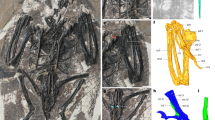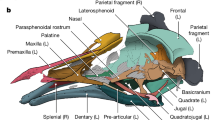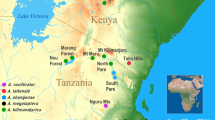Abstract
I SENT you a short note some weeks ago announcing the discovery of a species of the Mauritian genus Aphanapteryx—which I had named Aphanapteryx hawkinsi—in the Chatham Islands. I have just returned thence from a visit made expressly for the purpose of searching for further remains of this bird, of which I received at first only the cranium. I have been very fortunate in my search, and have procured several most perfect crania, with tibiæ and femora, which I have no doubt belong to the same bird, as more than once I discovered these bones in the immediate neighbourhood of the crania. The bones have been disinterred from the lower beds of a sandbank facing the shore. Some years ago, a great storm, followed, as I am told, by a tidal wave of great height, broke the Eurybiaprotected shore bluff; and now the wind, having carried off the upper bed of light-coloured sand into the lands behind, is continually planing down more and more the brown lower bed in which these bones seem mostly to be entombed. They are in a most perfect state of preservation, and very complete, though deprived of all their animal matter. Of the Aphanapteryx crania some are considerably larger and some much smaller than A. Brackei, the larger reaching to within 1/20 inch of 6 inches from the top of the slender arched upper mandible to the occiput. The tibiæ and femora vary in size corresponding to the differences in the crania; but they present the main characters of the bones figured by M. Milne-Edwards in his “ Oiseaux fossiles de la France.” It may yet turn out that more than one species of Aphanapteryx inhabited the Chatham Islands. It is very singular that, among the thousands of bones that have been collected from different swamps, Maori middens, and caves in various parts of New Zealand, not a single bone of this bird should have come to light. In one refuse heap from a Moriori feast laid bare by the wind on the beach of Petre Bay, I found several specimens of Aphanapteryx hawkinsi, along with crania and other bones of ducks, swan, sea-birds, seals, whales, &c. Swan-bones were everywhere very abundant in this brown sand bed; some of them indicating birds equal in size to Chenopis atrata, others considerably exceeding it. In one very ancient midden the remains I dug up consisted almost entirely of swan-bones, with the intermixture of only a few duck-bones. The Aphanapteryx must, I think, be the wingless bird spoken of by the Morioris as Mehiriki, although those to whom the skull has been shown fail to recognize the bird at all. They speak also of another flightless bird by the name of Mehunui. This bird, one old and very intelligent Moriori informed me, was the same as the Maoris called Kakapo. Mr. Alexander Shand, an old resident in the Chatham Islands, and the sole European living versed in Moriori customs and traditions, and capable of speaking their language with fluency, also confirmed this information, and told me that the Kakapo (according to the Morioris) was very abundant in the islands prior to 1836. He himself in the early days had seen their burrows often. I had observed, while collecting, several Psittacine bones, and on learning this fact I felt sure that those I had picked up and packed away must belong to Stringops. On my arrival here, however, I find so far that there are no Kakapo bones in the collection, the Psittacine bones being the head and beaks of Nestor notabilis, the Kea. I have as yet had time to do no more than run through the collection I have brought back; but there appear to be in it several large Ralline tibiæ of species unknown to me. I am looking forward to another opportunity of thoroughly exploring these interesting islands with more time at my disposal than I could afford on this occasion.
This is a preview of subscription content, access via your institution
Access options
Subscribe to this journal
Receive 51 print issues and online access
$199.00 per year
only $3.90 per issue
Buy this article
- Purchase on SpringerLink
- Instant access to full article PDF
Prices may be subject to local taxes which are calculated during checkout
Similar content being viewed by others
Author information
Authors and Affiliations
Rights and permissions
About this article
Cite this article
FORBES, H. Aphanapteryx in the New Zealand Region. Nature 45, 580–581 (1892). https://doi.org/10.1038/045580c0
Issue date:
DOI: https://doi.org/10.1038/045580c0



